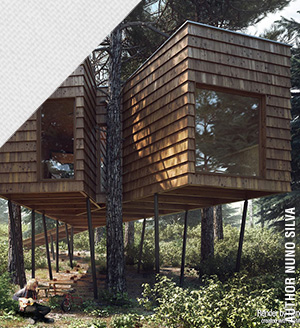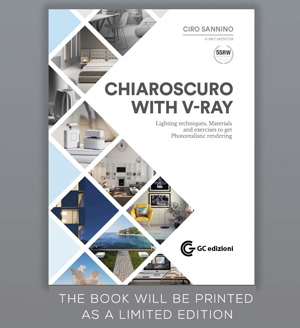In these lesson I’ll talk about Materials:
How color mapping works and how to setup V-Ray materials.

Contents for this lesson:
- 3 HD VIDEO LESSON (35′ narrated by a Licensed V-Ray Trainer)
- What is the Color Mapping and what is it useful for
- How works Exponential Color mapping
- How works Reinhard Color mapping
- Burn value in Reinhard
- V-Ray Real Time features
- Draw region
- Real Zoom
- Manage Fresnel IOR for glass
- How fall off works
- How to use Fall off for fabrics
- How to use Fall off for car paint
- Create reflection maps
- Download the lightbalance-file to start the exercise
- Download the complete materials-file to check the settings
[private Premium|Premium-1year|5trainings]
* STEP 3 | V-RAY MATERIALS *
Color Mapping
There’s a big confusion on internet about Color Mapping. Everyone tell his story and sometimes you can think Color Mapping is a mysterious option and something too complicated to understand in deep. Color mapping option comes from photography and it simply is the tone compression: a useful tool to use in order to avoid overexposures.
Watch the video:
Concepts:
- Basically you should use Linear Multiplier (default color mapping)
- Use Exponential just in case you overexposed areas
- Reinhard is a mix from linear and exponential
- Reinhard = Burn value 1,0 = LINEAR behavior
- Reinhard = Burn value 0,0 = EXPONENTIAL behavior
- For little overexposed area use Reinhard and play “Burn” value until overexposures are gone
Nobody gives you anything for nothing:
Exponential avoid overexposures, and to do that reduce the contrast,
so keep this in mind and remember to increase the contrast with curves.
* For more info about Color Mapping check the Lesson 10
 V-Ray Real Time – New Features
How V-Ray RT works and a couple of interesting new features: DRAW REGION and REAL ZOOM.
Concepts:
- Load V-Ray RT in active shade
- Just click actiove shade to start it
- Disable warning massages if you don’t like
- Use DRAW REGION to focus the render in a specific region (RT becomes really fast!)
- Use REAL ZOOM to get closer to the object without moving your camera
V-Ray RT is a really great tool to use in your workflow, you can really speed up all the process.
Get the latest version to use Draw Region and Real Zoom.
V-Ray Materials
Create great glass, understand how FALL OFF works, create a reflection map for the ground.
Concepts:
- Unlock L and increase Fresnel IOR to get more reflective objects
- Don’t abuse of fresnel IOR
- Fall off map allow us to have a color in the front view and nother color in the tangent view
- Use bright color in the tangent view to simulate fabrics
- Use curves in Fall off to control the distribution of this effect
- Create a reflection map in photoshop getting strong contrasts
- In Bitmap/Filtering: select None instaed of Pyramidal to get more detailed textures
Of course you can also use texture in fall off in order to ger more realistic fabrics. The concept is always the same: a color or texture ofr a front view, another one for the tangent. Click to magnify the image below:
* For more info about V-Ray Materials check the Lesson 8 and the V-Ray Library
 Â Exercise
 Exercise
Download the START file (link#1) and start creating 3 materials:
Glass / Fabric with Fall off / Ground with reflection map.
For any doubt check the FINAL file  (link#2)
- Download the START Max file and carry out the excercise
- Download the FINAL Max file
In this lesson we talked about color mapping and 3 materials.
In the next I’ll release the final scene with all textures and materials applied.
[/private]
 / Also Learn Corona Renderer
/ Also Learn Corona Renderer




Hi Ciro, I just started a 1year subscription and I see your website is FULL of super-interesting lessons!!! thank you and keep up working 😀
Another great lesson…. great piece, thank you!!!!
I’m already studing your material 🙂
Thank you for your support, I’m learning a lot you’re great
and your method is F-A-N-T-A-S-T-I-C.
Hi Ciro thank you for your efforts.. I feel your passion and I’m so happy to be here!! 1 question 4u: so what is the color mapping I have to use generally? Thank you for your time!
Hi Lucas,
basically use LINEAR, always use linear… exponential/reinhard are a “compromise” to avoid overexposures. The bad point is that exponential reduce the contrast. So LINEAR, EXPONENTIAL just in case of overexsposures.
I was waiting for your lesson… thank youuuuuuuuuu *_*
I am watching your new lesson.. very nicely done !!!
thank you ciro !!!!
Thanks Ciro exelent chapter 🙂
Just wonderful Ciro! You have done a great work!
I have a question about Draw region and Real zoom. Can we use these features if we activate the active shade through our viewport as you did at the end of your second video?
Thank you Viktoria!!
About your question… yes of course you can use DrawRegion and RealZoom in the viewport-Real Time 😉
hi
how we can define the exact value of each resolution Light Cache?
Hi Soufiane,
impossible to determine the exact value: it depends on the scene, the textures, the quantity and typology of the details. In my opinion 2000 is a good value for final and detailed renders. Anyways there’s no formulas, and remember that the “exact value” will NEVER improve the aesthetic impact of your scene.
Ciro, I notice that your max have a same bug that I’m experience with my 3dsmax. The right-clik menu(quads) didn´t appears completely, we have to scroll to show its full content. Have an idea to fix it? Thanks
Hi marcos,
I got the bug you see just while recording the screen. During the usual work Ive never experienced this kind of problem.
Hi Ciro, this lesson is super awesome, I’ve learned so much more in such a less time that I’ve learned in all my years (about 5) using and trying to find information about color mapping in vray!! thank you so much!!